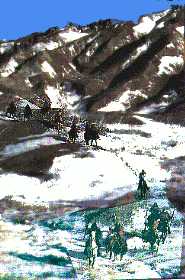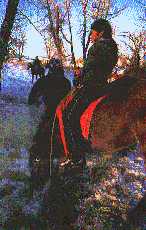
 Young Adults Books
Young Adults Books

 Young Adults Books
Young Adults Books|
PG Note: There's a wonderful video of the first Wounded Knee winter Memorial ride of 1990, when the Bigfoot Riders were founded. See Arvol Looking Horse's Pages for more info about the Bigfoot Riders from Arvol Looking Horse, one of the leaders. See the Audio-Visual Page here for more info about the video and how to order. A second Look: Contrary to Brock's Review Note, there's only a 4-page introduction that shallowly summarizes the 1890 Wounded Knee massacre (historical photos and a good map would have improved this a lot); I don't really see any reason for omitting Ghost Dancing from the cause of the situation.
Wanbli goes on the last of the 5 prophesied rides, 1990 being the 100th anniversary of the massacre. On all of these rides in deep winter, snow, wind on the open prairie, and weather challenged the riders. Wanbli is more sensible than I believe would be true of a white 8-year-old: "My dad and lala (grandpa) gathered our horses from the pen where they had eaten and slept in the cold. Were they suffering like we were, I wondered?...We stayed on small dirt roads for a while because of all the fences on the farmland. We passed strange places with barbed wire and satellite dishes. My dad told me these were nuclear missle silos. It made me think of other people being killed in wars. In the beginning, Uncle Birgil told us to pray for wolakota (peace) and that masacres like Wounded Knee would never happen again anywhere. When I saw those silos, I prayed." Later in the day, Wanbli's horse is spooked and he's thrown. He doesn't know if he can make it to the night's camp, " but my dad kept telling me that I could, that I had to. It was the only way to get back. Finally, far off on the plain, I saw the tepees....My uncle carried me to his truck to get warm. I stayed in there a few hours and ate, and got my strength back. Luckily, my arm wasn't broken. I'd be able to ride again. In the evening after everyone ate, my mom, dad and I went to the big campfire to listen to stories. It was so cold we all wrapped up in one big blanket and got as close to the fire as we could." Wanbli decides without parental pressure that he will not ride the next day, when the riders must go down the Big Foot pass, an icy cliff trail. "If I got hurt badly, I couldn't finish th ride...it was better to rest up and be strong later. Everybody understood. I was disappointed but I wasn't ashamed." No one is hurt on the pass. Wanbli sees the small group of fasters, and the sweat lodge they are preparing. "I saw how strong our people could be and I felt honored to be a Lakota. I wanted to fast too, but I got too hungry." He checks on his horse and finds he's escaped from the field, but his dad tracks the horse 20 miles into the snowy Badlands and brings him back. At the last night's camp, "Lakota men made big pots of Indian beef soup and fry bread. There was coffee, cake and sweet berry syrup. Usually, the women made the food for the riders, but that night the men were doing everything to honor the women for their strength and support. My mom, dad, sisters and I sat around a big fire with everybody else and ate. While we ate, uncle Birgil talked about the suffering and the honor of the women in the Lakota culture and the world. He talked about Grandmother earth too. He said the earth was suffering because we haven't taken care of her. He said we have to respect the earth, like our mothers. The earth was the very first woman, he said, the mother of us all. After Birgil spoke, every woman told a story about being a woman. Some were funny, some were sad, but all were honorable." (Boy, how I wished that Wood or somebody would have included those stories!) It's hard to stop quoting from this wonderful book. I should mention the photos by Ted Wood, co-author. These are in color, and appear on every page of the horizontally-designed 8 x 12 book. They give a good feeling for the cold on the snowy ride -- Wanbli's face mask is entirely crusted with ice in one close-up. What I most wish for, for this book is that, now that 6 years have passed since the last of the 5 Wounded Knee memorial rides, Wanbli would write a sequel about how it has affected his life and that of others. That could be added to it, perhaps with words of some of the elders and women who participated. In the years since, the Big Foot Riders have been making a circuit of places in the U.S. and in recent years, Canada. This could be added. The resulting book might receive the serious attention it deserves. from adults as well as children. This is one of the best Indian books I've read, for Native people of all tribes and all ages. It belongs in every Native home and school. It is worth 10,000 of the dreary "multicultural education" books about Native people generally written by white people. If this edition sells out and is re-issued, there are some additions that wound improve it. Six years have passed (now) and Wanbli is a teenager. He should add a section on what the Ride has meant to his life so far, and about any further involvement he's had with the Bigfoot Riders, who have become a permanent sacred-task group, riding for Native unity at massacre memorials all over the U.S. and Canada. Second, there really should be a better -- less shallow -- introduction about the 1890 Wounded Knee massacre, with maps and photos. Third, the book's one map of the 1990 Riders' route is quite inadequate, and should be supplemented with a more detailed large map. It would clarify Wanbli's daily narratives to have small inset maps of that day's route marking incidents, too. I would also like to see a bibliography of selected readings on Wounded Knee and Lakota history, and I do object to such things as a key quote (Black Elk, about the Nation's hoop being broken, from Black Elk Speaks) attributed so inadequately. A bibliography should include the $30 videotape on the Bigfoot Wounded Knee Memorial Ride. which any school using this book would surely want to show. Ideally, the bibliography would include selections of reading levels, including adult books for teacher historical background. Still, without these wished-for addenda, the book is an outstanding must-have for any school's Native studies. Because its author-hero is just 8 years old, it will appeal to young children of around that age, who may need help with the reading or vocabulary. But it has something to say to any age, including adults, and there is nothing babyish about its style or content that would make teenage youths scornful. Reviewed by Paula Giese File: ya318, mi 211
Purchase this book now from |
|---|
 BOOK Menu
BOOK Menu A BOY BECOMES A MAN AT WOUNDED KNEE by Ted Wood with Wanbli Numpa
Afraid of Hawk. Walker and Company, 435 Hudson St., N.Y., NY
10014, (800) AT-WALKER, (212) 307-1764 FAX. Illustrated, map. 48
pp., $6.95 paper. 0-8027-7446-6. Library hardbound version also available
A BOY BECOMES A MAN AT WOUNDED KNEE by Ted Wood with Wanbli Numpa
Afraid of Hawk. Walker and Company, 435 Hudson St., N.Y., NY
10014, (800) AT-WALKER, (212) 307-1764 FAX. Illustrated, map. 48
pp., $6.95 paper. 0-8027-7446-6. Library hardbound version also available Wanbli Numpa Afraid of Hawk, an eight-year-old Oglala Lakota
from the Cheyenne River Reservation, recounts the story of the Wounded
Knee massacre in 1890. On the 100th anniversary of the tragic
event, the boy participates in a 150-mile journey, retracing the
steps of Big Foot and braving temperatures of 50 degrees-below-zero
to mend the sacred hoop. When the final ceremony is over, Wanbli
Numpa is a Big Foot rider. Wood's photographs depict the riders
braving the frigid conditions, offering prayers, and honoring the
dead warriors. A powerful document, should be required reading in
classes studying Native Americans. Ages: 10+ Grade: A. Reviewed by: Steve Brock
Wanbli Numpa Afraid of Hawk, an eight-year-old Oglala Lakota
from the Cheyenne River Reservation, recounts the story of the Wounded
Knee massacre in 1890. On the 100th anniversary of the tragic
event, the boy participates in a 150-mile journey, retracing the
steps of Big Foot and braving temperatures of 50 degrees-below-zero
to mend the sacred hoop. When the final ceremony is over, Wanbli
Numpa is a Big Foot rider. Wood's photographs depict the riders
braving the frigid conditions, offering prayers, and honoring the
dead warriors. A powerful document, should be required reading in
classes studying Native Americans. Ages: 10+ Grade: A. Reviewed by: Steve Brock Wanbli tells the story of his family's and his own participation in the last 6-day winter memorial ride in his own words, which are eloquent. It's been objected to that this is really Wood's writing. I do not agree with that objection. It is clear that Wood functioned as a reporter and followed Wanbli around with a tape recorder, then transcribed and edited the narrative. That's pretty standard for "as told to" biographies even of supposedly literate adults. (Wanbli and his family carefully reviewed the transcripts and feel the book is quite accurate.) The person who told me her objections feels it would have been a more honest book if Wood had written it and put some narrative from Wanbli in quotes. Again I disagree. As the words all really did come from Wanbli, it makes for a much more powerful and immediate story that is very involving for Native (and presumably other) youth this way. I would in fact like to see more of this style of reporter-writing of Indian books, if done honestly and skillfully. In fact, this is a commonplace of Native biographies, almost all of the "cultural lifestyle" ones by traditional pople are as-told-to someone, usually an anthropologist, but rarely a real and skillful writer. Most of the anthros were ponderous, wooden prose stylists, who couldn't organize the material that their sources provided, either, but it doesn't have to be bad writing to be authentic!
Wanbli tells the story of his family's and his own participation in the last 6-day winter memorial ride in his own words, which are eloquent. It's been objected to that this is really Wood's writing. I do not agree with that objection. It is clear that Wood functioned as a reporter and followed Wanbli around with a tape recorder, then transcribed and edited the narrative. That's pretty standard for "as told to" biographies even of supposedly literate adults. (Wanbli and his family carefully reviewed the transcripts and feel the book is quite accurate.) The person who told me her objections feels it would have been a more honest book if Wood had written it and put some narrative from Wanbli in quotes. Again I disagree. As the words all really did come from Wanbli, it makes for a much more powerful and immediate story that is very involving for Native (and presumably other) youth this way. I would in fact like to see more of this style of reporter-writing of Indian books, if done honestly and skillfully. In fact, this is a commonplace of Native biographies, almost all of the "cultural lifestyle" ones by traditional pople are as-told-to someone, usually an anthropologist, but rarely a real and skillful writer. Most of the anthros were ponderous, wooden prose stylists, who couldn't organize the material that their sources provided, either, but it doesn't have to be bad writing to be authentic!